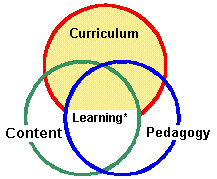![]()
Other topics
The following is an attempt to outline some aspects of the relationships between
-
intended curriculum ( principles, purposes, programs, policies, content... exists various levels, eg, school system, school, class, individual )
-
potential pedagogy (teaching and learning processes) that could be adopted
-
potential content (learning to be achieved) that is meaningful for the learner
-
actual learning* achieved
[NB. 'All models are wrong but some are useful']

In this model the curriculum informs the selection of both content and pedagogy
What if Marshall McCluan was right when he said that the "medium is the message"? One of the implications is that, in practical terms, education is defined more by pedagogy that by content. And mediated learning, which includes the application of quality principles and practices, is the best currently known medium for communicating and managing the learning processes.
Mediated Learning* addresses many of the issues that arise from the model, eg,
-
identifying what is to be learned (relevant content) - see steps 1 & 2 below
-
how the learning is to be achieved and how we will know - see 3 & 4 below
-
how we know the learning has occurred (use data, attend to processes...)
-
embedding the learning in a way that is valuable to the learner
-
ensuring that the learning has known on-going value
1. (Jointly) Choose a focus from within content
2. Check on prior knowledge
3. Design a learning task
- new content (knowledge....)
- methodology/pedagogy
4. Do it !!- learner attempts learning task
- the processes are planned and monitored
- teacher mediates thinking & learning processes used by the learner
5. Review learning
- new knowledge... acquired & demonstrated
- critical success factors in achieving the learning
- about self; hopes, preferences, SWOT....
6. Transference of learning
- how to utilise the learning achieved in new situations
- what new opportunities for learning have been created
NOTES
The above diagram tends to partially separate official Curriculum from the real learning Content (achieved or possible).
One of the aims of education is to expand this Content circle because this will lead to the achievement of the purposes of education, viz, the success and well-being of the learner and those with whom he/she is associated.
The key to this expansion is not so much expanding Curriculum . This is the usual approach but it inevitably leads to curriculum overload and all sorts of waste and rework for everyone. This also means that delivery of Curriculum ought not to be the purpose of any education system.
Pedagogy that focuses on learning to think, learning, do and relate expands the actual and potential (available new) Content is the key. If adopted and well managed (teacher as skilled and sensitive leader), mediated learning and learning matrices can cause
- the Pedagogy and Curriculum to increasingly overlap,
- Curriculum to shrink to manageable proportions
- Content to expand to meet the needs of the learner (exponentially?)
- greater potential for joy in learning (and teaching)
These proposals represent a change of paradigm and thus present enormous challenges and opportunities for everyone in the field (leadership at all levels is critical).
![]()